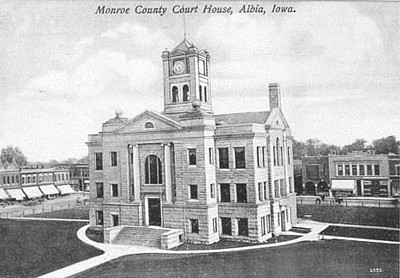History of Monroe County's Courthouse
The first court in Monroe County was held at the John CLARK residence in Clarksville in what was then known as Kishkekosh County. The court convened there for a short time when plans were made to build a courthouse on the square at Princeton in 1846. This building was of logs and was built at a cost of $75.00. It was located in the east side of the square near the alley and was a log structure 20 feet square and 14 feet in height. An additional sum of money was appropriated for chinking and for 50 light of glass and a loft. It was used approximately 12 years. It was torn down and logs were split to make a sidewalk around the square.
The first time court was held in Monroe County, it was convened in a log house at Clark's Point, Judge Charles MASON presiding. There was no floor in the house and during the session the judge, the layers, and the court officials slept on the ground. There being no barn, the horses were tied under the trees. One night a severe storm arose, the horses were brought into the courtroom and stabled until morning. This incident gave rise to the story that the first court was held in a barn.
First mention of the name Albia in board proceedings was July 4, 1848, although actual incorporation took place March 26, 1859. The name of the county was changed to Monroe at some time prior to this date as it was called Monroe at the time of the incorporation.
The second courthouse was a building of brick on the location of the present structure. It was planned in January 1858, at a contracted cost of $10,900.00 with an additional $450.00 in 1859. In 1860, a second courthouse constructed in medieval style of the Tudor with a total cost of $11,350.00.

This building was replaced by the present structure, which was approved by voters in November 1901, at a cost of $75.000.00 later increased to $100,000.00. The cornerstone was laid on August 29, 1902; the three-story sandstone building was dedicated on October 26, 1903. This building has served the county well for a long time and has been the center of much progress in many ways, as well as the housing of the judicial head of the county. It is a beautiful building with possibilities of serving Monroe County for many years.
This building greatly influenced later building design in Albia in two ways. It introduced stone as building material and neo-classical style architecture to the business district. You can see this influence in many of the buildings on the square now.
Oliver O. SMITH of Des Moines was employed as architect to draw plans and specifications for the new courthouse and to superintend the construction.
James ROWSON and Son of Iowa City, Iowa constructed the new courthouse as per plans and specifications of O. O. SMITH contract signed April 10, 1902. The original bid was $69,550.00 included materials from the old courthouse, but didn't include fixtures, heating, etc. The contract states the stone to be used will be Cleveland stone known as "Grey Canyon".
The three-story structure of sandstone has Tennessee Marble floors in the halls, vestibules, stair landings and the toilet rooms. There is marble base in the halls and toilet rooms. There is wood base in all rooms and wainscoting cap in the courtroom.
The Board of Supervisors made a change in the contract to wainscot the halls, vestibules, stair landings and up the wake stairs on the three floors 3 foot 6 inches high with marble, also to make a marble floor in from the public spaces in the main offices same as halls with a 10 inch marble base. Also, to furnish marble stair treads in place of slate as specified.
The counters are pink Tennessee marble fronts and tops not less than 30 inches on the top. Auditor, clerk and Recorders are 42 inches high. The Treasurer's counter is 42 inches high and to have a screen 42 inches high, the screen for 12 inches above the top of the counter to be beveled plate glass, obscure and above this to be grill work. The screen is to be supplied with 3 wickets hinged and to have locks. This grill work is still in place.
The Clerk of Court's office has a metal spiral stairway connecting them directly with the courtroom on the third floor.
A 1,000-pound pure metal bell composed of new Lake Superior copper [78 parts] and East India black tin [22 parts] was also purchased from Seth Thomas at a cost of $300. The bell was removed from the clock tower in 1970, and is now displayed on the east side of the courthouse park. The clock now operates electrically and the bell has not been used in some time. The courthouse exterior was sandblasted and cleaned as part of the renovation program in Albia during 1970.
A Seth Thomas tower clock was purchased and installed in the courthouse tower at a cost of $740.00.
The corner stone laid August 29, 1902 at the Northeast corner of the building is inscribed:
The Board of Supervisors:
Samual ELDER, Chairman
William JUDGE
J. K. WATSON
~ ~ ~ ~ ~ ~
O. O. SMITH Architect
G. W. SALISBURY Superintendent
~ ~ ~ ~ ~ ~
James ROWSON & Son
Contractors and Builders
on the North side and 1902 on the east side of the inscription.
$975,000 - voted in July 1990, for renovation sub-floor support, elevator, new heating system.
This building was named to the National Register of Historic Places on July 2, 1981.
Submission by Sharon R. Becker, October of 2010

